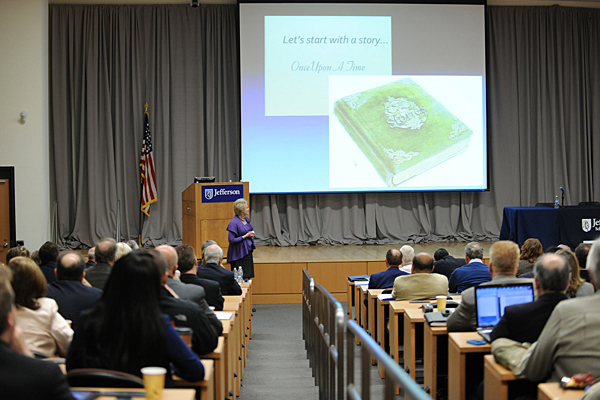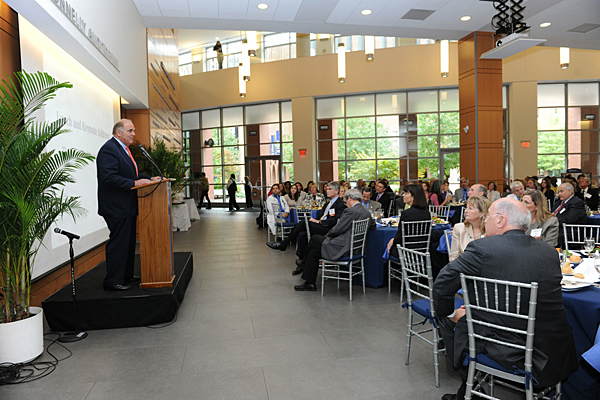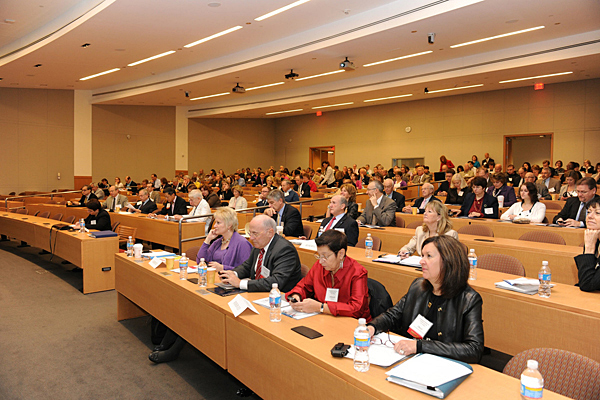Collaborating for better care
Conference addresses health care workforce needs for 21st century
2:27 p.m., Oct. 31, 2011--Health care is big business. In 2009, hospitals in Delaware—the second smallest state in the U.S.—employed more than 18,000 people, and annual hospital payroll was more than $1 billion. In Pennsylvania, hospitals and health systems support more than half a million jobs and provide some $40 billion in direct spending to the state’s economy.
On Friday, Oct. 21, more than 250 people heard these statistics and more at a conference co-hosted by the University of Delaware and Thomas Jefferson University that addressed health care workforce needs for the 21st century. All of the speakers at the conference used numbers to tell stories about enrollment, employment and economic impact.
Campus Stories
From graduates, faculty
Doctoral hooding
Susan Dentzer, editor-in-chief of Health Affairs, also used numbers to tell the cautionary tale of an individual’s experience. Dentzer described a “complex web of care” that resulted in an 88-year-old woman, the mother of former Kaiser Permanente CEO David Lawrence, being seen by 80 providers during treatment for a fractured femur. The total included physicians, physical and occupational therapists, social workers, nurses, and nurses aides from at least seven different countries.
Dentzer said Lawrence referred to his mother’s care as an “ad-hoc-racy” that “involved well-trained and well-intentioned people, state-of-the-art facilities and remarkable technologies—but was not joined into a coherent whole for the benefit of her or her family.”
She also shared his comment that at times his mother’s care “seemed like a pick-up soccer game in which the participants were playing together for the first time, didn’t know each other’s names, and wore earmuffs so they couldn’t hear each other.”
The overall message from all of the speakers was that health care needs to be better coordinated, both to bring costs down and to provide better outcomes for patients from infants to the elderly.
Recommendations and themes for improving health care as reform is implemented across the nation included value-based payment and purchasing, community partnerships, interprofessional education, team-based training and strategies for transitional care. Medical students and other health care professionals need to be trained in not only procedural skills but also empathy and communication.
Joanne Conroy, M.D., chief health care officer of the Association of American Medical Colleges, noted that health care and training are shifting from a focus on the individual to a focus on the population, from a focus on illness to a focus on health, from paying for units of service to paying for outcomes, and from anecdotal evidence to evidence-based standards. Most important is a trend away from a hospital and physician-centric perspective to a patient-centered medical environment.
“We need to be more thoughtful about what we reward and what we allow,” Conroy said. “These are powerful drivers of culture.”
Michael Strazzella, senior vice president for the Hospital and Healthsystem Association of Pennsylvania, identified key actions for hospitals, including enhancing patient safety, minimizing avoidable readmissions, reducing racial and ethnic disparities, and strengthening plans for health information technology and electronic health records.
In a lunchtime keynote address, former governor of Pennsylvania Edward Rendell emphasized the need to link workers to jobs in demand, all while developing and grooming the next generation to pursue careers in health care.
“Our universities need to prepare to train the future workforce,” he said, “with a special emphasis on the areas where there will be gaps—health information technology, nursing, and physician assistants, to name a few. Partnerships like the Delaware Health Sciences Alliance go a long way toward addressing these issues across the tri-state region.”
After the conference, Kathleen Matt, dean of the UD College of Health Sciences, said the exciting message coming out of the event for the college was that investing in the health care workforce is wise—from an economic perspective, from a community perspective and from a national perspective. “If done right,” she said, “it results in jobs across the spectrum of health care, and it results in better health outcomes and fewer dollars spent for those outcomes.”
“There was a strong emphasis on interprofessional programs, the team approach to delivering health care, and a focus on patient- and family-centered approaches to care delivery,” added Matt, who is also executive director of DHSA. “These are all models that we are currently developing across our college.”
About the conference
In addition to the speakers quoted above, the conference program included welcoming remarks by Robert Barchi, president of TJU, Patrick Harker, president of UD, and David Nash, dean of the Jefferson School of Population Health; and two panel discussions, one focused on building a team-based workforce and the other on promoting and sustaining innovative approaches to workforce development.
The conference was part of UD’s Creating Knowledge-Based Partnerships series and was sponsored by DHSA.
About DHSA
DHSA was established in 2009 with four founding partners—Christiana Care Health System, Nemours/Alfred I. duPont Hospital for Children, Thomas Jefferson University, and the University of Delaware.
The alliance enables partner organizations to collaborate and conduct cutting-edge biomedical research, to improve the health of Delawareans through access to services in the state and region and to educate the next generation of health care professionals.
DHSA’s unique, broad-based partnership focuses on establishing innovative collaborations among experts in medical education and practice, health economics and policy, population sciences, public health, and biomedical sciences and engineering. For more visit information, visit the website at http://www.dhsa1.org.
Article by Diane Kukich













